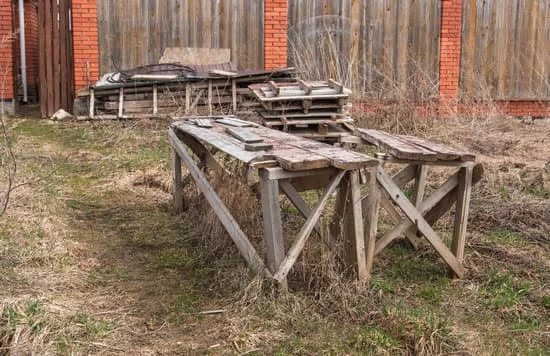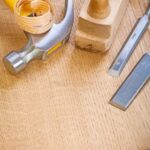Varnished woodwork can add a touch of elegance and beauty to any space. However, over time, the varnish can start to wear away, leaving the woodwork looking dull and lackluster. That’s where refreshing varnished woodwork becomes crucial. By taking the time to refresh your varnished woodwork, you can revive its natural luster and enhance the overall aesthetic of your space.
Refreshing varnished woodwork is important for several reasons. Firstly, it helps to maintain the integrity of the wood by protecting it from potential damage caused by moisture, sunlight, and everyday wear and tear. Without regular maintenance, varnished woodwork can become susceptible to scratches, water stains, and discoloration.
Additionally, refreshing varnished woodwork allows you to extend its lifespan. By addressing any signs of wear and tear and applying a fresh coat of varnish when needed, you can help prevent further damage and ensure that your woodwork remains sturdy and beautiful for years to come.
Lastly, refreshing varnished woodwork provides an opportunity to enhance the overall look of your space. A well-maintained piece of varnished woodwork can serve as a focal point or complement other design elements in your home or office. It adds warmth, depth, and character to any room.
In this article, we will guide you through the process of refreshing varnished woodwork step by step. From understanding different types of varnish to properly prepping the surface and applying a new coat of varnish – we’ve got you covered.
We’ll also address common issues that may arise during the process and provide tips for long-lasting maintenance. Join us as we explore how revitalizing your space with refreshed varnished woodwork can make all the difference in transforming your interior design vision into reality.
Understanding the Basics of Varnished Woodwork
Varnish is a commonly used finish for woodwork, providing both protection and an attractive appearance. Understanding the basics of varnished woodwork is important when refreshing the finish. In this section, we will explore the different types of varnish and their characteristics.
There are several types of varnish available, each with its own unique properties and uses. Here are some of the most common types:
- Polyurethane Varnish: This type of varnish is known for its durability and water resistance. It provides a hard protective coating that can withstand heavy wear and tear, making it suitable for high-traffic areas such as floors or tabletops.
- Spar Varnish: Spar varnish is specifically designed for outdoor use, as it provides excellent protection against sunlight, moisture, and temperature changes. It is commonly used on wooden boats, outdoor furniture, and doors.
- Shellac: Shellac varnish is derived from natural resin secreted by Lac insects in Southeast Asia. It dries quickly and provides good protection against water damage. Shellac has a warm amber color that can enhance the natural beauty of wood.
- Water-Based Varnish: Water-based varnishes are becoming increasingly popular due to their low toxicity and eco-friendly nature. They are easy to clean up with water and dry quickly, making them convenient to use.
When choosing a varnish for your woodwork refresh, consider factors such as the level of durability required, the intended use of the piece, and personal preference for appearance. Each type of varnish has its own set of characteristics that can affect the final result.
To recap, understanding the basics of varnished woodwork begins with exploring the different types of varnish available and their unique characteristics. By selecting the right type of varnish for your specific needs, you can ensure a successful refresh that not only protects your woodwork but also enhances its beauty for years to come.
Assessing the Condition of Your Varnished Woodwork
When it comes to refreshing varnished woodwork, it is essential to assess the condition of your wood surfaces before diving into the process. By identifying signs of wear and tear, you can determine the extent of restoration needed and plan accordingly. Understanding the condition of your varnished woodwork will also help you choose the right techniques and products for a successful refresh.
Inspecting for Scratches and Blemishes
Begin by carefully inspecting your varnished woodwork for any visible scratches or blemishes. These may occur due to heavy use, accidental impacts, or normal wear over time. Small scratches can often be easily repaired, but deeper ones may require more extensive restoration efforts.
To identify scratches and blemishes, examine the surface from different angles and lighting conditions. Use your fingers to feel for any rough areas or irregularities that may not be immediately visible. Keep in mind that certain types of wood, such as softwoods like pine, are more prone to scratches than hardwoods like oak or mahogany.
Identifying Water Stains
Water stains are another common issue that can affect varnished woodwork. These stains occur when water penetrates through the protective varnish layer and causes discoloration in the underlying wood fibers. Identifying water stains is crucial because they may require different treatment methods compared to scratches or blemishes.
Water stains typically appear as dark spots or rings on the surface of the wood. They may be concentrated in certain areas where water has come into contact with the varnish. It’s worth noting that some water stains can be removed through simple cleaning methods, while others may require sanding and refinishing.
Evaluating General Wear and Fading
Over time, varnished woodwork can experience general wear and fading. The effects of sunlight, temperature fluctuations, and regular use can cause the varnish to lose its luster and protective properties. By evaluating the overall condition of your woodwork, you can determine whether a simple refresh is enough or if a complete refinishing is necessary.
Look for signs of fading, such as areas where the varnish appears dull or discolored compared to other areas. Pay attention to any areas where the varnish has completely worn off, leaving the bare wood exposed. These spots may require extra attention during the refreshing process to ensure even and consistent results.
Preparing Your Woodwork for Refreshing
Before refreshing your varnished woodwork, it is crucial to properly prepare the surface to ensure optimal results. This section will outline the essential steps you should take before starting the process of refreshing your woodwork.
Section Preparation: Clearing the Area and Protecting Nearby Surfaces
The first step in preparing your woodwork for refreshing is to clear the area around it. Remove any furniture, decor items, or other objects that may obstruct your work or get in the way. This will provide you with ample space to maneuver and work comfortably.
It is also important to protect nearby surfaces from accidental spills or splatters during the refreshing process. Cover the floor and any adjacent furniture with drop cloths or plastic sheets to prevent any damage or staining. Additionally, use painter’s tape to secure these protective covers in place, ensuring that they don’t shift or move during the process.
Removing Existing Varnish: Techniques and Tools to Ensure a Smooth Surface
Before applying a new coat of varnish, it is vital to remove the existing varnish from the woodwork. This allows for better adherence of the new varnish and helps achieve a smooth and even finish.
There are several techniques for removing varnish, including sanding, chemical stripping agents, heat guns, and scraping tools. The choice of method depends on factors such as the type and condition of your woodwork.
Sanding is one of the most commonly used methods for removing varnish. Start by using coarse-grit sandpaper (around 80 or 100-grit) to roughen up the surface and remove any loose varnish or imperfections. Then gradually move on to finer grits (such as 120 or 150-grit) until you achieve a smooth and even surface.
Chemical stripping agents can also be effective in removing varnish. These products soften the varnish, making it easier to scrape off. Follow the manufacturer’s instructions carefully and ensure good ventilation when using chemical strippers.
Regardless of the method you choose, it is important to wear appropriate safety gear, such as gloves and goggles, to protect yourself from any chemicals or debris that may be generated during the varnish removal process.
Repairing Damaged Areas: Addressing Scratches, Blemishes, and Water Stains
Once you have removed the existing varnish, it is a good time to address any visible scratches, blemishes, or water stains on your woodwork. While varnish can enhance the natural beauty of wood, it does not hide imperfections.
To repair these damaged areas, start by cleaning them with a mild detergent and water solution. For deeper scratches or gouges, you may need to use wood filler or putty to fill in the gaps. Allow the filler to dry completely before sanding it down until it is level with the surrounding area.
For water stains, gently sand the affected area with fine-grit sandpaper until the stain disappears. If needed, apply a wood bleach solution followed by a matching wood stain to restore the color and grain pattern.
By taking these essential steps to prepare your woodwork before refreshing it with new varnish, you will create a solid foundation for achieving exceptional results. Proper preparation ensures that your refreshed varnished woodwork looks beautiful and lasts for years to come.
| Preparing Your Woodwork for Refreshing Checklist |
|---|
| 1. Clear the area around the woodwork. |
| 2. Protect nearby surfaces with drop cloths or plastic sheets. |
| 3. Secure protective covers in place with painter’s tape. |
| 4. Choose the appropriate method for removing the existing varnish (sanding, chemical stripping agents, heat guns, scraping tools). |
| 5. Wear safety gear (gloves and goggles) during varnish removal. |
| 6. Clean damaged areas with a mild detergent and water solution. |
| 7. Use wood filler or putty to repair scratches or gouges. |
| 8. Allow filler to dry completely before sanding it down. |
| 9. Gently sand water stains until they disappear. |
Step-by-Step Guide
Refreshing varnished woodwork can breathe new life into your space and restore the beauty of your furniture and trim. Whether you’re looking to update the look of your woodwork or simply want to maintain its durability, following a step-by-step guide can help you achieve professional results. In this section, we will outline the essential steps involved in refreshing varnished woodwork.
a) Section Preparation: Clearing the Area and Protecting Nearby Surfaces
Before you begin refreshing your varnished woodwork, it’s important to clear the area of any furniture or objects that could hinder your progress. This will allow you to have a clear workspace and avoid any accidental damage. Additionally, be sure to protect nearby surfaces such as floors or walls with drop cloths or plastic sheets to prevent any potential staining or splattering.
b) Removing Existing Varnish: Techniques and Tools to Ensure a Smooth Surface
To achieve optimal results when refreshing varnished woodwork, it’s crucial to remove the existing varnish from the surface effectively. There are several techniques and tools you can use for this step, including chemical strippers, heat guns, or sanding.
Chemical strippers work by softening the varnish so it can be scraped away easily, while heat guns use heat to loosen the varnish for removal. Sanding is another common method that involves using sandpaper or a sander to smooth out the surface.
c) Repairing Damaged Areas: Addressing Scratches, Blemishes, and Water Stains
After removing the old varnish, carefully inspect the woodwork for any scratches, blemishes, or water stains that may need attention. Small scratches can often be buffed out with sandpaper by gently rubbing in circular motions until they blend with the surrounding wood.
For deeper scratches, fill them in with a wood filler using a putty knife and lightly sand the area once it’s dried. Water stains can be removed by gently rubbing the affected area with a mixture of equal parts vinegar and olive oil.
| Section | Description |
|---|---|
| Section Preparation | Clear the area and protect nearby surfaces |
| Removing Existing Varnish | Use techniques like chemical strippers, heat guns, or sanding to remove old varnish |
| Repairing Damaged Areas | Address scratches, blemishes, and water stains with appropriate methods |
Troubleshooting Common Issues
Dealing with Drips
One common challenge that may arise when refreshing varnished woodwork is the presence of drips or runs in the varnish. Drips can occur if too much varnish is applied at once or if the brush strokes are not evenly distributed. To tackle this issue, it is important to act quickly before the varnish dries.
Use a small, clean brush or a toothpick to gently remove any excess varnish by dabbing or scraping it off the surface. Be careful not to apply too much pressure as this may damage the woodwork. Once the excess varnish has been removed, allow the surface to dry completely before applying another coat of varnish.
Uneven Coatings
Another challenge that one may face when refreshing varnished woodwork is achieving an even coating on the surface. Uneven coatings can result in a patchy appearance and may be caused by various factors such as improper application techniques or inadequate preparation of the woodwork. To address this issue, it is crucial to prepare the woodwork properly by sanding it down smooth and cleaning away any dust or debris beforehand.
Additionally, ensure that you are using the right tools such as a high-quality brush or sprayer for applying the varnish. Apply thin coats of varnish instead of thick layers to ensure better control and coverage. If you still notice uneven coatings after applying multiple thin coats, lightly sand down the surface between coats and ensure each layer is completely dry before proceeding.
Other Challenges
Apart from drips and uneven coatings, there can be other challenges that one might encounter when refreshing varnished woodwork. These challenges include issues like bubbles in the finish, streaks, color inconsistencies, and drying problems among others. To address these challenges:
- Bubbles in the finish can be minimized by using a foam roller instead of a brush for application and avoiding excessive shaking or stirring of the varnish.
- Streaks can be prevented by applying the varnish in long, smooth strokes in the direction of the wood grain and ensuring that each stroke overlaps slightly with the previous one.
- Color inconsistencies can be addressed by using a stain or tinted varnish that matches the existing color of the woodwork more closely.
- Drying problems can be tackled by ensuring proper ventilation in the working area, avoiding high humidity levels, and giving sufficient time between coats for each layer to dry.
By being aware of these common challenges and taking proactive steps to overcome them, you can ensure a smoother and more successful process when refreshing your varnished woodwork.
Maintaining Refreshed Varnished Woodwork
Once you have successfully refreshed your varnished woodwork, it is important to maintain its beauty and ensure that it lasts for a long time. Proper maintenance can help prevent wear and tear, protect the surface from damage, and preserve the overall appearance of the woodwork. Here are some useful tips and guidelines to help you maintain your refreshed varnished woodwork:
- Regular Cleaning: Regularly clean the varnished woodwork using a soft, lint-free cloth or a microfiber duster. This will help remove any dust or debris that may accumulate on the surface. Avoid using harsh chemicals or abrasive cleaners as they can strip away the varnish or cause scratches.
- Avoid Excessive Moisture: Water can be damaging to varnished woodwork, so it is important to avoid excessive moisture contact. Wipe up any spills immediately and make sure to use coasters or placemats under cups or glasses to prevent water rings. In humid environments, consider using a dehumidifier to regulate moisture levels.
- Protect from Sunlight: Direct sunlight can cause fading and discoloration of varnished woodwork over time. To protect your woodwork, use curtains or blinds to block out direct sunlight during peak hours of the day or apply UV-protective film to windows.
- Prevent Scratches: Place felt pads under furniture legs and use mats or rugs in high traffic areas to prevent scratching of the woodwork surface. Avoid dragging heavy objects across the woodwork as this can also cause scratches.
- Regular Maintenance: Periodically check your refreshed varnished woodwork for any signs of wear or damage. Touch up any scratched areas with matching stain or new varnish if necessary. Inspect for loose or chipped areas and repair them promptly to prevent further damage.
By following these tips and guidelines, you can ensure that your refreshed varnished woodwork retains its beauty and durability for years to come. Remember, proper maintenance is key to enjoying the long-lasting effects of your hard work in refreshing your woodwork.
Enhancing the Look
When refreshing varnished woodwork, it is important to consider how the new finish will complement and enhance the overall look of your space. Varnished woodwork has a timeless appeal and can add warmth and elegance to any room. By combining it with other design elements, you can create a cohesive and harmonious aesthetic that truly elevates the space.
One way to enhance the look of varnished woodwork is by choosing complementary colors for walls, furniture, and décor. For example, if you have dark woodwork with a rich varnish, consider pairing it with walls painted in a light or neutral shade to create contrast and make the woodwork stand out. Conversely, if your woodwork is lighter in color, you can opt for darker or bolder wall colors to create a more dramatic effect.
In addition to wall colors, furniture and accessories play a significant role in enhancing the look of varnished woodwork. When selecting furniture pieces, consider their style and finish. For instance, vintage or antique furniture made from similar types of wood can create a cohesive and classic look when paired with varnished woodwork. Modern or minimalist furniture with clean lines can provide an interesting contrast against traditional varnished woodwork.
To further enhance the aesthetic appeal of your varnished woodwork, incorporate other design elements such as textiles, lighting fixtures, and artwork. Soft furnishings like curtains or upholstery in complementary colors or patterns can add depth and texture to the space. Well-placed lighting fixtures can help highlight the beauty of the woodwork while also creating ambiance. Artwork displayed on walls can serve as focal points that draw attention to both the woodwork and the artwork itself.
By thoughtfully combining varnished woodwork with other design elements in your space, you can achieve a cohesive and visually pleasing result. Whether you prefer a traditional or contemporary look, there are endless possibilities for creating an appealing aesthetic that showcases the beauty and craftsmanship of your varnished woodwork.
Frequently Asked Questions
Refreshing varnished woodwork can be a daunting task for many homeowners, especially for those who are new to the process. In this section, we will address some common queries and provide answers to help you navigate through the project with confidence.
- Q: What is the best time of year to refresh varnished woodwork?
- A: The best time to refresh varnished woodwork is during mild weather conditions when humidity and temperature levels are moderate. Extreme temperatures or high humidity can interfere with the drying and curing process of the new varnish, resulting in a less satisfactory finish. It is generally recommended to avoid conducting this project during hot summer months or cold winter seasons.
- Q: Can I refresh varnished woodwork without removing the existing varnish?
- A: While it is possible to apply new varnish on top of the existing one without removing it, it is generally not recommended. Layering new varnish on top of old varnish can lead to an uneven and unattractive finish. Additionally, any damage or imperfections present in the previous coating will still be visible after refreshing. To achieve optimal results, it’s best to remove the existing varnish before applying a new one.
- Q: How long does it take for newly refreshed varnished woodwork to cure fully?
- A: The drying and curing time of freshly applied varnish can vary depending on several factors such as temperature, humidity levels, type of varnish used, and thickness of application. On average, most water-based varnishes require 24-48 hours to dry completely between coats and around two weeks to cure fully.
Oil-based varnishes typically have longer drying times and can take up to 72 hours between coats and several weeks for full curing. It’s important to check the manufacturer’s instructions for specific guidelines.
By addressing these frequently asked questions, we hope to alleviate any concerns or uncertainties you may have about refreshing varnished woodwork. Remember to follow proper preparation and application techniques for the best results, and don’t hesitate to seek professional help if needed. With the right knowledge and dedication, you can transform your space with beautifully refreshed varnished woodwork.
Conclusion
In conclusion, refreshing varnished woodwork can have a significant impact on revitalizing your space. By understanding the basics of varnished woodwork and being able to assess its condition, you can effectively prepare for the refreshing process. Following a step-by-step guide, you can remove existing varnish, repair any damaged areas, and apply a new varnish for a professional finish. Troubleshooting common issues and maintaining the refreshed varnished woodwork are also important steps to ensure long-lasting beauty.
Refreshing varnished woodwork not only enhances the appearance of your space but also adds value to your home. It allows you to bring back the original beauty of the wood while protecting it from everyday wear and tear. With proper care and maintenance, your refreshed varnished woodwork can last for many years to come.
To further enhance the look of your space, consider combining varnished woodwork with other design elements. Mixing different textures and materials can create a visually appealing contrast that adds depth and character to your home. Whether it’s pairing varnished woodwork with metal accents or incorporating it into an eclectic style, there are endless possibilities for creating a unique and inviting environment.
Frequently Asked Questions
How do you rejuvenate varnished wood?
Rejuvenating varnished wood can breathe new life into dull and worn-out surfaces. One common method is to start by cleaning the wood thoroughly with a mild soap and water solution, removing any dirt or grime buildup. Once dry, you can lightly sand the surface to smooth out any rough spots or imperfections, using a fine-grit sandpaper.
Afterward, apply a fresh coat of varnish using a brush or rag, following the direction of the wood grain. Allow it to dry completely before applying additional coats if needed. This process helps restore the sheen and beauty of varnished wood, giving it a renewed appearance.
How do you refresh stained wood trim?
Refreshing stained wood trim is an effective way to revitalize its color and luster. Begin by cleaning the trim using a mixture of warm water and mild detergent to remove dirt, dust, and grease from the surface. Once dry, inspect the stain for any scratches or damage that may need repairing; minor scratches can be easily touched up with matching stain markers or pencils available at hardware stores.
For areas with more severe damage, you may need to consider sanding them lightly before applying a fresh coat of stain to blend in with the rest of the trim. Finally, seal and protect the refreshed stained wood trim using an appropriate sealant or topcoat for added durability.
How do you restore wood furniture without stripping it?
Restoring wood furniture without stripping it is possible through various methods that focus on enhancing its appearance while preserving its original character. Start by cleaning the furniture thoroughly with a gentle cleaner designed specifically for wood surfaces, followed by drying it completely. If there are minor scratches or imperfections present, you can use specialized products like scratch repair pens or wax fillers designed for wooden furniture to minimize their visibility.
To revive its natural shine, apply a high-quality furniture polish or wax using a soft cloth, following the manufacturer’s instructions carefully. Additionally, you may consider reconditioning the wood by applying a coat of oil or furniture rejuvenator, which can help nourish and protect the wood without stripping off its existing finish. Regular maintenance like dusting and avoiding direct sunlight or excessive humidity will help to preserve the restored look of the wood furniture for years to come.

Hi everyone! I’m a woodworker and blogger, and this is my woodworking blog. In my blog, I share tips and tricks for woodworkers of all skill levels, as well as project ideas that you can try yourself.





